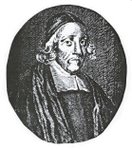Thesis 01 Baker
At least 8 academic theses have been written on Thomas Adams in the last 40 or 50 years. These are written chiefly within the discipline of an English Literature approach rather than anythuing more strictly theological. I have gleaned this information from ProQuest. The first of these is
The Homileic Satires of Thomas Adams
(Diss. University of Notre Dame, 1982)
Abstract: The present study offers a reading of the sermons of Thomas Adams in the light of the theological, homiletic, and literary traditions familiar to him. The purpose of such a reading is to discern Adams' distinctive homiletic mode and to demonstrate how his characteristic manner enables him to work upon the mind and affections of his auditors in order to initiate in them the process of conversion. In so doing, the work advances the thesis that the most characteristic mode in Adams' sermons is satirical as he seeks to rebuke sin and initiate the process of conversion in his auditors. In arguing this thesis, the study attempts to demonstrate how Adams uses satiric structure, the satiric prose character," satiric imagery, and the range of tones available to the satirist in order to advance his auditors along the successive stages of the morphology of conversion as defined by Puritan theologians. The thesis is based on the assumption that the Puritan theology of conversion provided preachers with a psychic model which presents the movement and renewal of the psychological faculties necessary for conversion. The study then proceeds to demonstrate how Adams uses the structure, technique, and style of satire in order to enact, through the experience of the sermon, the process of conversion in the faculties of his auditors.
Chapter 1 provides biographical and bibliographical information on Adams and isolates his central concern with conversion.
Chapter 2 studies the structure of Adams' sermons in light of both the homiletic structures advanced by contemporary ecclesiastical rhetoricians and the structure present in much classical and Renaissance verse satire.
Chapter 3 analyzes Adams' use of the satiric "character," and demonstrates his development of a homiletic "character" which contributes to his preaching of conversion.
Chapter 4 focuses upon Adams' use of satiric imagery.
Chapter 5 demonstrates how Adams uses the curt and loose Senecan styles in order to support his preaching of conversion; the chapter then dwells upon the range of tones found in Adams. The study ends with a discussion of the prophetic voice in Adams as he assimilates satire into prophecy.
Chapter 1 provides biographical and bibliographical information on Adams and isolates his central concern with conversion.
Chapter 2 studies the structure of Adams' sermons in light of both the homiletic structures advanced by contemporary ecclesiastical rhetoricians and the structure present in much classical and Renaissance verse satire.
Chapter 3 analyzes Adams' use of the satiric "character," and demonstrates his development of a homiletic "character" which contributes to his preaching of conversion.
Chapter 4 focuses upon Adams' use of satiric imagery.
Chapter 5 demonstrates how Adams uses the curt and loose Senecan styles in order to support his preaching of conversion; the chapter then dwells upon the range of tones found in Adams. The study ends with a discussion of the prophetic voice in Adams as he assimilates satire into prophecy.








No comments:
Post a Comment